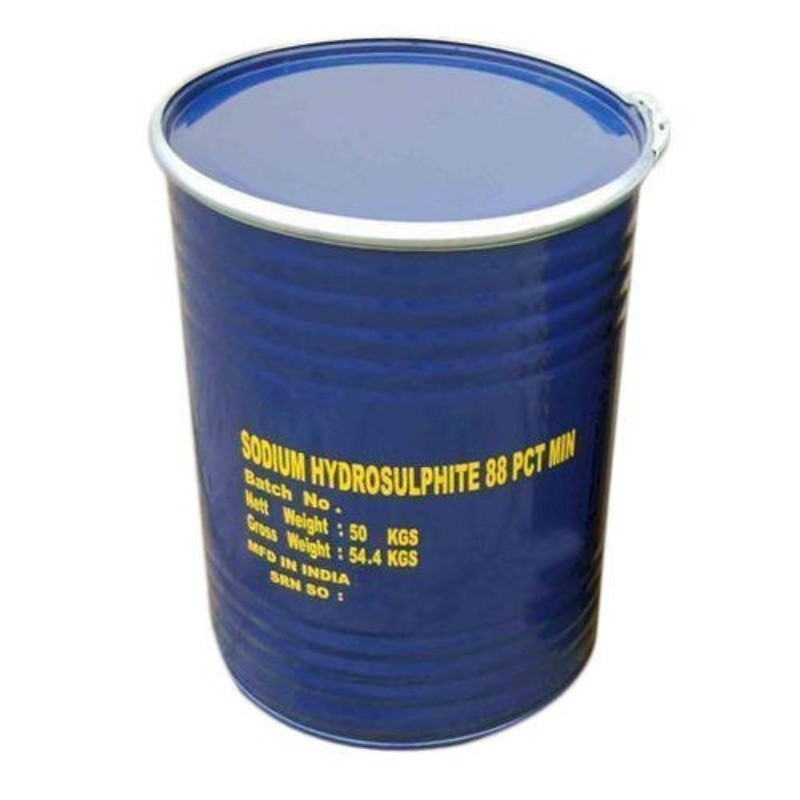Product Specification
| Country of Origin | Made in India |
| Molar Mass | 174.107 g/mol |
| Boiling Point | Decomposes |
| Formula | Na2S2O4 |
| Melting Point | 52 Degree C |
| Other Anions | Sodium sulfite, Sodium sulfate |
| Packaging Type | Drum |
Sodium hydrosulfite is also very effective in bleaching recycled pulp because sodium hydrosulfite is a strong reducing agent and can effectively react with the dyes in the pulp. Also, most recycled furnish usually contains some mechanical pulps that can be bleached by sodium hydrosulfite. The bleaching conditions for recycled pulp by sodium hydrosulfite are very similar to those for mechanical pulps. If the furnish, such as mixed office waste, contains mainly chemical pulps, significant brightness gain could be achieved by performing a hydrosulfite (Y) stage at a much higher temperature, 80–100°C and at pH of 7.0.
Sodium dithionite is a reductive bleaching chemical. It is also known as sodium hydrosulfite. Reductive bleaching is especially essential not only for bleaching but also for removing color from colored recovered paper and carbonless paper (Hache et al., 1994, 2001). Many dyes used to color paper can be effectively destroyed by reductive bleaching chemicals. Sodium dithionite is known to be effective for color stripping and can remove many types of dyes. Most of the acidic and direct dyes are permanently decolorized by sodium dithionite because it breaks the azo groups. Some of the basic dyes are temporarily decolorized. Dithionite is sometimes used in combination with an oxidizing agent, as some dyes which are not reactive with oxidizing chemicals can react with some reducing agents.
Sodium dithionite decomposes rapidly when exposed to air. When exposed to water, the solid form liberates sulfur gases which are corrosive to equipment and buildings. The aqueous solution is typically stored in closed tanks with a nitrogen pad. Sodium dithionite is generally supplied as dry powder. These commercial products may contain stabilizers, buffers (phosphates, carbonates), and chelates.
Dithionite was produced for the first time in 1906 by BASF in Germany in powder form. Initially, the product was obtained by the zinc dust process. Zinc is first converted into zinc dithionite in an aqueous solution with sulfur dioxide and then by sodium hydroxide to sodium dithionite and zinc oxide. Later on, a process was developed which uses the sodium amalgam from the mercury cell electrolysis of sodium chloride solution and converts this directly to sodium dithionite with sulfur dioxide. This process produces a material which is free of heavy metals and therefore stable. Chlorine-alkali electrolysis in Europe is changing from the amalgam process to the diaphragm process due to the mercury content of the wastewater. BASF later developed the formate process in which sodium formate is converted with bisulfite to sodium dithionite. Sodium formate is produced from carbon monoxide and sodium hydroxide.
Dithionite was used for the first time for bleaching of mechanical pulp in the 1930s. Initially, sodium dithionite was used in small amounts as a powder. The bleaching effect was limited because the bleaching time and the temperatures were too low. Good results were obtained when atmospheric oxygen was excluded. With the introduction of continuous bleaching processes such as tower bleaching, the use of solutions of dithionite proprietary blends became necessary to ensure their homogeneous mixing with stock. Another option is the use of cooled, alkalized solutions of sodium dithionite. At temperatures below 10°C, these solutions are so stable that they can be stored for long periods. This eliminates the complicated process of dissolving the powder.

Login To Comment